Theoretical Probability
or
Classical Probability
Moving forward to the theoretical probability which is also known as classical probability or priori probability, we will first discuss about collecting all possible outcomes and equally likely outcome.
Collecting all Possible Outcomes:
When an experiment is done at random we can collect all possible outcomes without actually doing the experiment repeatedly.
For example:
- If a coin is tossed, either a head (H) or a tail (T) will show.
- If a die is rolled, it will show either 1 or 2 or 3 or 4 or 5 or 6.
- If two coins are tossed simultaneously, either HH or HT or TH or TT will show. (TH means tail on the first coin and head on the second coin.)
Thus, the collection of all possible outcomes in tossing a coin consists H, T. So, there are only two different outcomes in tossing a coin.
The collection of all possible outcomes in throwing a die consists of 1, 20, 3, 4, 5, 6. So, there are only six different outcomes in a trail of throwing a die.
The collection of all possible outcomes in tossing two coins simultaneously consists of HH, HT, TH, TT. So, there are only four different outcomes in a trail of tossing two coins.
Equally Likely outcome:
When an experiment is done at random, any one of the possible outcomes may take place. If the possibility of each outcome taking place is the same, we say the outcomes are equally likely.
If a perfectly manufactured coin is tossed, the outcome H (head) and the outcome T(tail) are equally likely. But if half of the coin on head's side is heavier then it is more likely that T will appear on the top. So, if a defective (biased) coin is tossed the outcomes H and T are not equally likely. In what follows all the outcomes in a trail will be assumed to be equally likely.
Classical Probability: The classical probability of an event E, denoted by P (E) is defined as below
P(E) = Number of Outcomes Favourable to the Event ETotal Number of Possible Outcomes in the Experiment
Definition of Theoretical Probability:
Let a random experiment produce only finite number of mutually exclusive and equally likely outcomes. Then the probability of an event E is defined as
Number of favorable outcomesP(E) = Total number of possible outcome
The formula for finding the theoretical probability of an event is
Number of favorable outcomesP(E) = Total number of possible outcome
Theoretical probability is also known as Classical or A Priori probability.
To find the theoretical probability of an event we need to follow the above explanation.
Problems based on Theoretical Probability or Classical Probability:
1. A fair coin is tossed 450 times and the outcomes were noted as: Head = 250, Tail = 200.
Find the probability of the coin showing up
(i) a head
(ii) a tail.
Solution:
Number of times coin is tossed = 450
Number of heads = 250
Number of tails = 200
(i) Probability of getting a head
Number of favorable outcomesP(H) = Total number of possible outcome
= 250/450
= 5/9
(ii) Probability of getting a tail
Number of favorable outcomesP(T) = Total number of possible outcome
= 200/450
= 4/9
2. In a cricket match the Sachin hit a boundary 5 times out of 30 balls he plays. Find the probability that he
(i) hit a boundary
(ii) do not hit a boundary.
Solution:
Total number of balls Sachin played = 30
Number of boundary hit = 5
Number of times he did not hit a boundary = 30 - 5 = 25
(i) Probability that he hit a boundary
Number of favorable outcomesP(A) = Total number of possible outcome
= 5/30
=1/6
(ii) Probability that he did not hit a boundary
Number of favorable outcomesP(B) = Total number of possible outcome
= 25/30
= 5/6
3. The record of
weather stations report shows that out of the past 95 consecutive days,
its weather forecast was correct 65 times. Find the probability that on a
given day:
(i) it was correct
(ii) it was not correct.
Solution:
Total number of days = 95
Number of correct weather forecast = 65
Number of not correct weather forecast = 95 - 65 = 30
(i) Probability of ‘it was correct forecast’
Number of favorable outcomesP(X) = Total number of possible outcome
= 65/95
= 13/19
(ii) Probability of ‘it was not correct forecast’
Number of favorable outcomesP(Y) = Total number of possible outcome
= 30/95
= 6/19
4. In a society 1000 families with 2 children were selected and the following data was recorded
Find the probability of a family, having:
(i) 1 boy
(ii) 2 boys
(iii) no boy.
Solution:
According to the given table;
Total number of families = 333 + 392 + 275 = 1000
Number of families having 0 boy = 333
Number of families having 1 boy = 392
Number of families having 2 boys = 275
(i) Probability of having ‘1 boy’
Number of favorable outcomesP(X) = Total number of possible outcome
= 392/1000
= 49/125
(ii) Probability of having ‘2 boys’
Number of favorable outcomesP(Y) = Total number of possible outcome
= 275/1000
= 11/40
(iii) Probability of having ‘no boy’
Number of favorable outcomesP(Z) = Total number of possible outcome
= 333/1000
More solved examples on theoretical probability or classical probability:
5. Two fair coins are tossed 225 times simultaneously and their outcomes are noted as:
(i) Two tails = 65,
(ii) One tail = 110 and
(iii) No tail = 50
Find the probability of occurrence of each of these events.
Solution:
Total number of times two fair coins are tossed = 225
Number of times two tails occur = 65
Number of times one tail occur = 110
Number of times no tail occur = 50
(i) Probability of occurrence of ‘two tails’
P(X) = Total number of possible outcome
= 65/225
= 13/45
(ii) Probability of occurrence of ‘one tail’
Number of favorable outcomesP(Y) = Total number of possible outcome
= 110/225
= 22/45
(iii) Probability of occurrence of ‘no tail’
Number of favorable outcomesP(Z) = Total number of possible outcome
= 50/225
= 2/9
6. A die is thrown randomly four hundred fifty times. The frequencies of outcomes 1, 2, 3, 4, 5 and 6 were noted as given in the following table:
Find the probability of the occurrence of the event
(i) 4
(ii) a number < 4
(iii) a number > 4
(iv) a prime number
(v) a number < 7
(vi) a number > 6
Solution:
Total number of times a die is thrown randomly = 450
(i) Number of occurrence of a number 4 = 75
Probability of the occurrence of ‘4’
Number of favorable outcomesP(A) = Total number of possible outcome
= 75/450
= 1/6
(ii) Number of occurrence of a number less than 4 = 73 + 70 + 74 = 217
Probability of the occurrence of ‘a number < 4’
Number of favorable outcomesP(B) = Total number of possible outcome
= 217/450
(iii) Number of occurrence of a number greater than 4 = 80 + 78 = 158
Probability of the occurrence of ‘a number > 4’
Number of favorable outcomesP(C) = Total number of possible outcome
= 158/450
= 79/225
(iv) Number of occurrence of a prime number i.e. 2, 3, 5 = 70 + 74 + 80 = 224
Probability of the occurrence of ‘a prime number’
Number of favorable outcomesP(D) = Total number of possible outcome
= 224/450
= 112/225
(v) Number of occurrence of a number less than 7 i.e. 1, 2, 3, 4, 5 and 6 = 73 + 70 + 74 + 75 + 80 + 78 = 450
Probability of the occurrence of ‘a number < 7’
Number of favorable outcomesP(E) = Total number of possible outcome
= 450/450
= 1
(vi) Number of occurrence of a number greater than 6 = 0,
Because when a die is thrown all the 6 outcomes are 1, 2, 3, 4, 5 and 6
so, there is no number greater than 6.
Probability of the occurrence of ‘a number > 6’
Number of favorable outcomesP(F) = Total number of possible outcome
= 0/450
= 0
Solved example problem on classical probability:
7. Find the probability of getting a composite number in a throw of a die.
Solution:
Let E = the event of getting a composite number.
Total number of possible outcomes = 6 (Since any one of 1, 2, 3, 4, 5, 6 can come).
Number of favourable outcomes for the event E = 2 (Since any one of 4, 6 is a composite number).
Therefore,
P(E) = Number of Outcomes Favourable to the Event ETotal Number of Possible Outcomes
= 26
= 13.
Probability
Probability of Tossing Two Coins
Probability of Tossing Three Coins
Probability for Rolling Two Dice
Probability for Rolling Three Dice
From Theoretical Probability to HOME PAGE
Didn't find what you were looking for? Or want to know more information about Math Only Math. Use this Google Search to find what you need.
Recent Articles
-
How to Do Long Division? | Method | Steps | Examples | Worksheets |Ans
Apr 20, 25 11:46 AM
As we know that the division is to distribute a given value or quantity into groups having equal values. In long division, values at the individual place (Thousands, Hundreds, Tens, Ones) are dividend… -
Word Problems on Division | Examples on Word Problems on Division
Apr 20, 25 11:17 AM
Word problems on division for fourth grade students are solved here step by step. Consider the following examples on word problems involving division: 1. $5,876 are distributed equally among 26 men. H… -
Subtraction of 4-Digit Numbers | Subtract Numbers with Four Digit
Apr 20, 25 10:27 AM
We will learn about the subtraction of 4-digit numbers (without borrowing and with borrowing). We know when one number is subtracted from another number the result obtained is called the difference. -
Subtraction without Regrouping |4-Digit, 5-Digit & 6-Digit Subtraction
Apr 20, 25 10:25 AM
We will learn subtracting 4-digit, 5-digit and 6-digit numbers without regrouping. We first arrange the numbers one below the other in place value columns and then subtract the digits under each colum… -
Worksheets on Missing Numbers from 1 to 20 | Counting Missing Numbers
Apr 20, 25 10:17 AM
Printable worksheets on missing numbers from 1 to 20 help the kids to practice counting of the numbers.



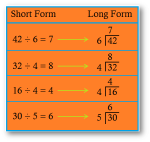
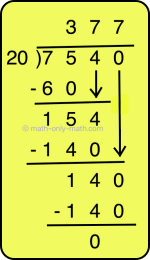
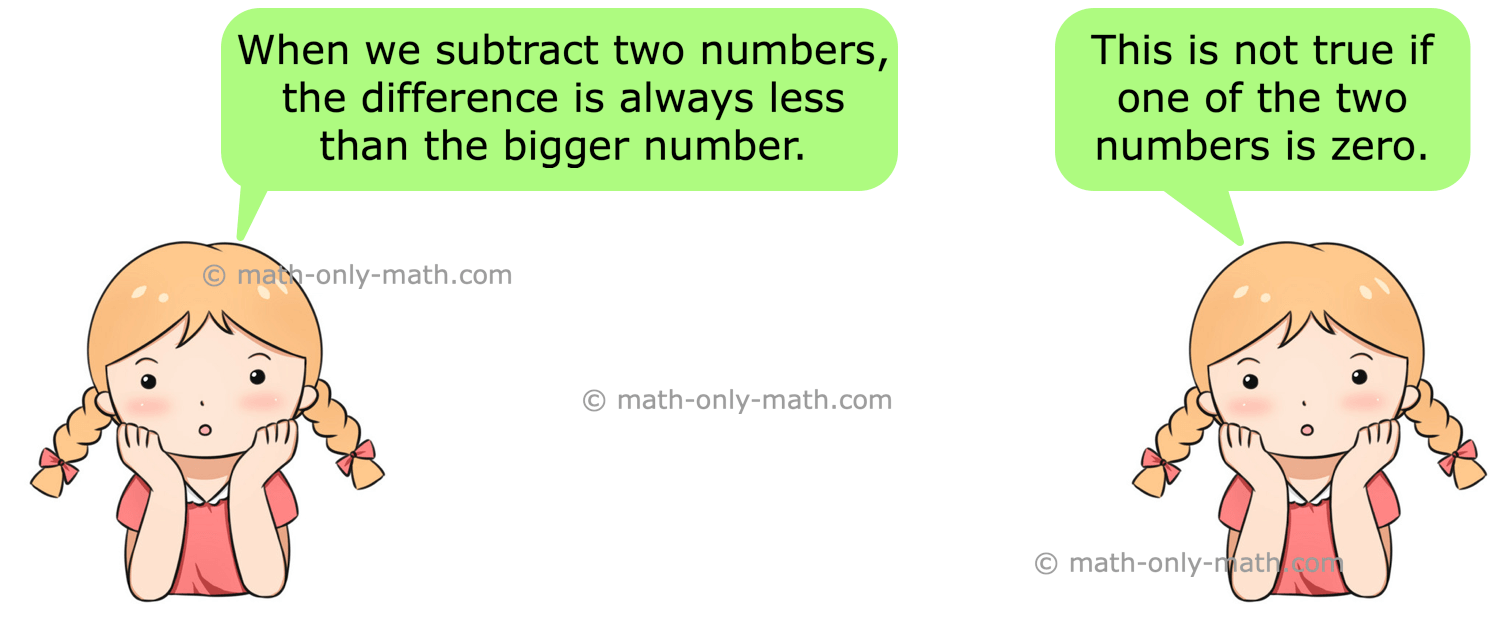
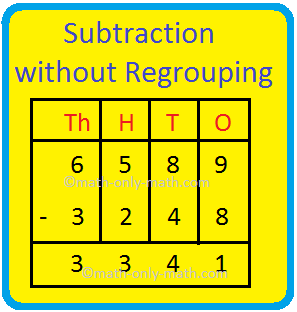
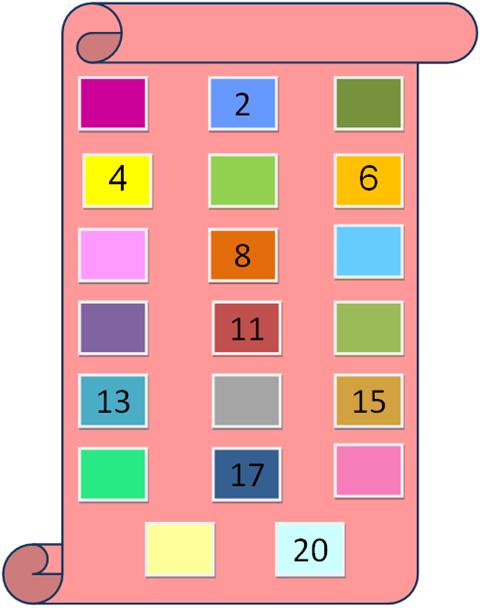
New! Comments
Have your say about what you just read! Leave me a comment in the box below. Ask a Question or Answer a Question.